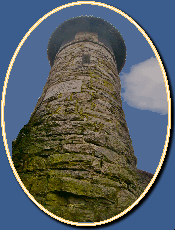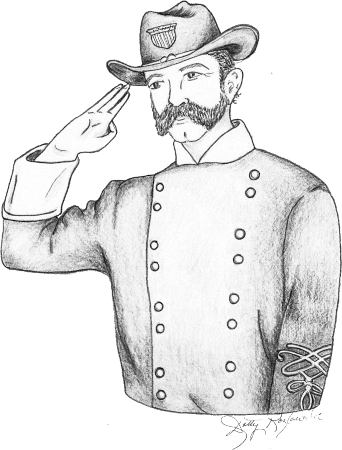Henry G. Marshall was born in Milford on January 2 1839, and resided at 89 West River Street with his family including two sisters, Hattie and Mary. A bright young man, Marshall, preparing for the ministry, graduated from Yale in 1860.
After the civil war broke out he enlisted August 4, 1862, in the 15th Connecticut Regiment at the rank of Sergeant. At that time, all of Connecticut's regiments contained only white men. Though allowed by the federal Government since 1862 it was not until November 1863 that Republican Gov. William Buchanan called for men of color to sign up. Hundreds did, so many in fact that the regiment was oversubscribed by January 1864.
A regiment is roughly 1,000 men who were allocated in the 29th in13 companies, A through L. The vast majority of men were former slaves or descendants of slaves. The first African slaves arrived in Boston on a Dutch ship in 1638, the same time as Milford’s founders arrived from England.
Slavery was made "legal" in Massachusetts and was not outlawed in Connecticut until 1848. So eager they were to fight “like Moses” for the freedom of their southern brothers that some from Rhode Island and New Jersey, and likely elsewhere, feigned Connecticut citizenship to join.
One claimed to be from Clinton but no record before or after the war exist to confirm this. Another man, Miggs,was a new African immigrant and sadly one of the first to die in battle.
On February 16, 1864, Marshall took a step up professionally by joining the Connecticut 29th U.S.C.(U.S. Coloreds) becoming a first lieutenant under the esteemed Colonel William B. Wooster, formally of the Connecticut 20th.
Wooster and his number two, Lt. Col. Ward, were beloved by the black troops for their compassion, courage and leadership. Even though there were more than 125 officers of African descent one rising to the rank of Major, all the commissioned officers of the 29th were white, at least partly to assuage Connecticut Democrats who feared that rapacious black men would ravage the south.
Marshall was promoted to captain on January 31, 1865, and assigned to lead Company I of the 29th regiment. In the histories of the 29th written by African American troops, Rev. J.J. Hill (1867) and Rev. Alexander H. Newton (1910), there is, sadly, no mention of Company I nor Capt. Marshall. However, the captain did write of the exploits of the 29th that confirm their accounts
The troop mustered and trained in Fair Haven. So many men had come that the full complement of the 29th was filled by January 1864 resulting in the formation of the Connecticut 30th Regiment. It was merged into the Connecticut 31st as even more volunteers arrived.
Approximately 75% of all eligible asking American men in Connecticut between the ages of 15 and 50 volunteered. Each volunteer was entitled to a signing bonus of $75 from the County, $310 from the state of Connecticut and $300 from the Federal government. However, these recruits only received the $310 from the state and then were surprised to receive just half of a white soldier’s pay.
Frederick Douglas spoke to inspire the men but all already knew what was at stake. The regiment paraded through New Haven to Long Wharf to the cheers and tears of whites and blacks I like. They set off from there in March 1864 to Annapolis to be armed with brand-new Springfield rifled muskets.
The regiment served valiantly in Hilton Head and Beaufort, South Carolina, where training and some skirmishes occurred before moving north to fight 30 battles in Petersburg and Richmond, VA. theaters among at least 75,000 African American troops.
Troops of the 29th were the first to enter Richmond and escorted Lincoln onto the fallen Confederate capital. After the war, the 29th was transported to Brazos De Santiago for garrison duty at Brownsville Texas. En route the only blemish on the 29th was a near mutiny. A rumor had gone out the men were being shipped to Cuba to be sold as slaves.
The officers and more sensible troops settled their fellows down. After a terrible and disrespectful experience in Texas they were ordered back to Connecticut in November 1865 for mustering out. Gov. Buckingham welcomed them back and lamented “… although Connecticut now denies you privileges which it grants to others… the voice of the majority of liberty-loving freeman will be heard demanding for you every right and every privilege."
The 13th, 14th and 15th amendments to the Constitution of United States banning slavery and granting legal rights were still years ahead and only passed over the Democrat opposition because of Republican control of the southern states during reconstruction.
In total, 23 were killed in action, 22 more died of their wounds while 153 died of disease. Men from Milford who served in the 9th included Capt. Marshall and first Lt. Charles L. Louden, and black soldiers, who included: Sgt. William Ricks, Cpl. Anson P. Jackson, Private Dwight A. Rallis, Pvt. Joseph Hanes, Pvt. James M. Hempstead, Pvt. David Jackson, Pvt. John Phillipo, and, Mus. Peter H. Billings, a "musician" and probably a trumpeter or drummer who was likely under-aged.
Henry Marshall mustered out separately from his troops on October 24,1865, as did Col. Wooster, who resigned his commission while they were in Texas. Marshall was a proud member of the George Van Horn Grand Army of the Republic (GAR) Post, equivalent of today's Veterans Associations. The G.A.R. had a meeting room in the second floor, center section, of the old Town Hall. Their records and paraphernalia were all destroyed when the Town Hall burned to the ground in 1910. (1915?)
After the war, Marshall attended Andover Theological Seminary and took up the ministry in September 1868. He married Mariette Crosby of Danbury, August 25, 1869, having one son, William, born September 21, 1870.
The Rev. Marshall served as minister of the First Church of Christ Congregational in Cromwell, Connecticut, from 1885 to 1904, where he was both evangelist and successful temperance fighter.
He returned to Milford to pastor a local church. In 1911 and 1912 he served as Chaplain of the Connecticut Legislature House of Representatives. He is buried in Milford Cemetery where his tombstone reads: "Captain Henry G. Marshall of Co. I 29th Conn. Vols., Died Oct. 11, 1918 AE 79, Rev. Minister of the gospel 45 years.”



